It's the second Thursday night of the month in Denver's edgy Santa Fe Drive arts district. As the galleries, shops and studios close up for the evening, the war fighters are gathering.
Lightning arcs across in the sky in rapid-fire bursts of light and thunder. The first fat drops of rain are already pounding down as dozens of combat veterans file into a rough-around-the-edges, turn-of-the-century warehouse building.
A storm is coming, but these vets have weathered far worse.
Welcome to Veterans of Foreign Wars Post No. 1. Formed in 1899, predating even the VFW itself, Post 1 is the oldest regular gathering of combat veterans in the country.
It was also very nearly one of the VFW's most recent casualties, part of a nationwide membership bleed-out that top leaders are struggling to staunch. But now, the first VFW post in the country is also in the vanguard of a radical rethinking of the organization — and what local chapters have to offer veterans.
This is their story.
Inside Post 1's walls, the veterans mingle.
Some are hunched over with age and memories that range back to fighting Nazis in Europe and to beach landings in the Pacific. Others are only a few weeks removed from the ongoing war in Afghanistan.
Just about every combat zone in the 70 years in between also is represented — from the big fights in Korea, Vietnam and the Middle East to the smaller skirmishes fought in Panama, Somalia, the Balkans and elsewhere.
For most VFW posts, that kind of diversity is unusual. But for Post 1, that's not the half of it.
"This VFW is ridiculously diverse. It's what VFW should be," says Army Reserve veteran Marla Keown, who drove trucks in Iraq. "We've got super old people, super young people, people of all colors, nations and races, sexual identities. We marched in the Pride Parade last year. What VFW post does that?"
Not the post she first tried to join.
"When I first got back from Iraq, I tried to join a post in Kansas. It was old dudes sitting at a bar drinking alone. It just wasn't fun. I could do that at my own house. So, yeah, nothing ever really came of it. But this place? This place is f---ing awesome."
It's certainly different. For better or worse, most VFW posts are known for their bars, dubbed canteens by the old-timers. Of the thousands of posts across the country, Post 1 is among the few without a bar.
Instead, these veterans are gathering inside the post's veteran-run art gallery. The whitewashed walls display photos, paintings and other works created mostly by members of the post.
One of them is Jim Stevens, a legally blind Vietnam veteran who commands one section of the gallery with his innovative portraits painted across hundreds of fishing-line monofilament threads drawn taut inside a glass case. The holographic-like work recently earned two first-place ribbons at the National Veterans Creative Arts Festival, edging out more than 3,300 other artists.
The meeting is about to begin.
Petty jealousies
Navy veteran and post commander Michael Mitchel is at the podium. After a few informal announcements and introductions, it's time to get down to business. Mitchel cracks a big gavel twice on the podium and everyone stands.
There's an opening prayer, followed by the pledge of allegiance.
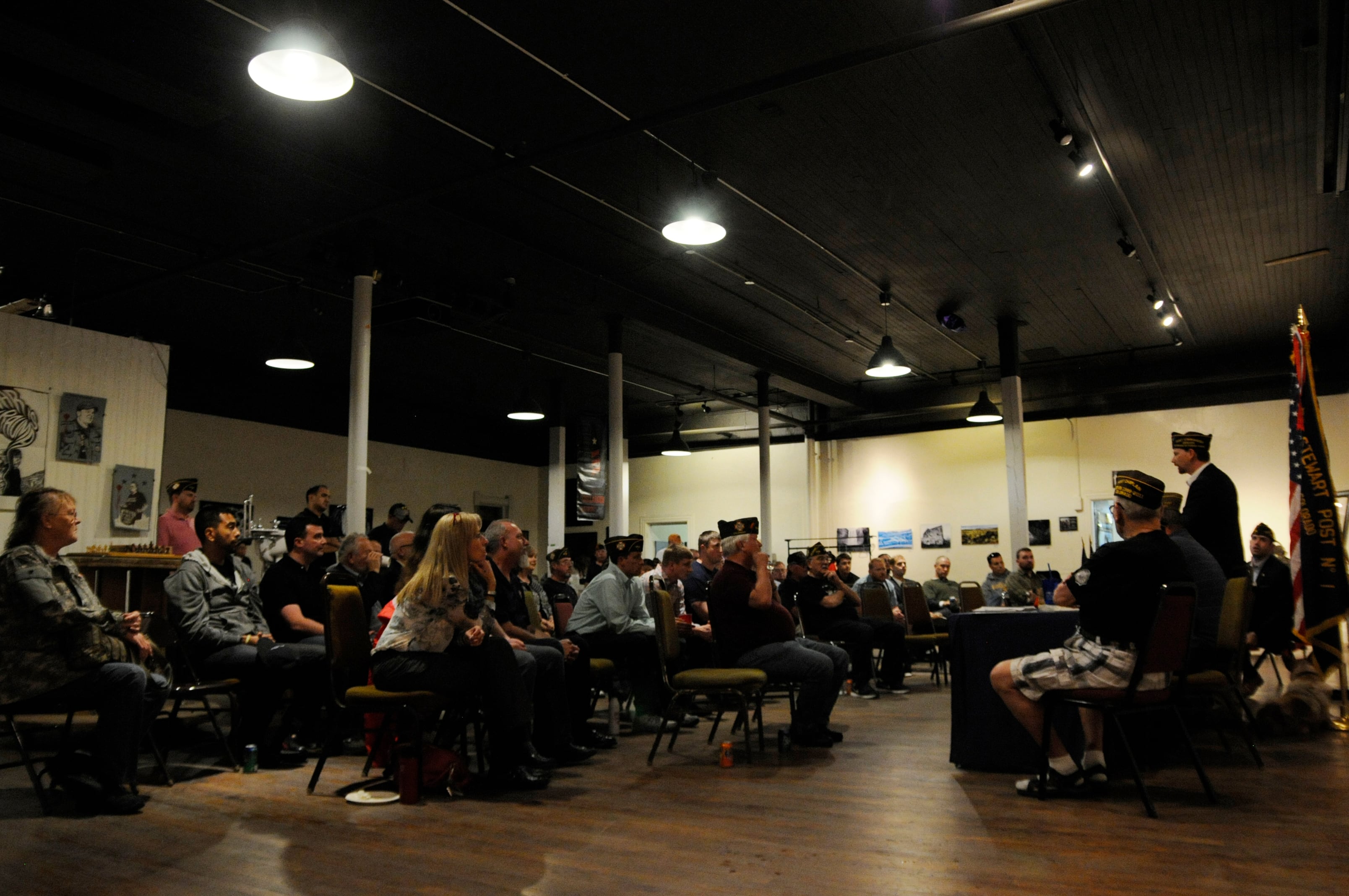
Members of Veterans of Foreign Wars Post 1 in Denver assemble for their June meeting.
Photo Credit: Jon R. Anderson/Staff
"Comrades, we are assembled again to transact business of mutual benefit," Mitchel says. "Do not let petty jealousies or trivial personalities influence our deliberation."
Those are the exact words post commanders have used to open VFW meetings for decades. But perhaps nowhere in the organization's 101-year history have those words been more important to heed.
Not all veterans can join. To be eligible, you must have received a campaign medal for overseas service; served 30 consecutive or 60 non-consecutive days in Korea; or received hostile fire or imminent danger pay at any point in your military career.
Against the back drop of those eligibility restrictions, the organization, to put it simply, is dying.
The dwindling twilight of the generation of World War II and Korea veterans makes that literally true. At the same time, there is a self-inflicted wound as those who remain do little to replenish the VFW's ranks.
The reasons vary, depending on who you ask. But atop the list, say some of the VFW's top leaders, are the kinds of "petty jealousies and trivial personalities" that post commanders warn against when they open post meetings.
The result is indisputable. Over the last two decades, VFW membership has plummeted by nearly half. Despite 14 years of continuous combat spanning the Middle East, Central Asia and Africa — and the more than 2.5 million troops who have deployed into those war zones — total VFW membership has dropped from 2.1 million veterans in 1995 to just 1.3 million now.
Meanwhile, in the last 10 years alone, one out of every four VFW posts across the country has been forced to shut down. And many others are on life support, with only a handful of remaining members to keep the lights on.
Mitchel, the Post 1 commander, knows all about it.
A little more than a year ago, this post was homeless, forced to sell its building because of mounting debt and dwindling membership. Members moved into their new home last June. It's come a long way but still needs work, as evidenced by the water that pours into a few strategically placed buckets from the leaky roof above.
Even so, this post is thriving.
With the storm raging outside, it's standing-room-only inside.
And that's when the lights go out. Literally.
If that seems ironic, what happens next is symbolic of just how this post has pulled though.
In the sudden darkness, Mitchel doesn't miss a beat.
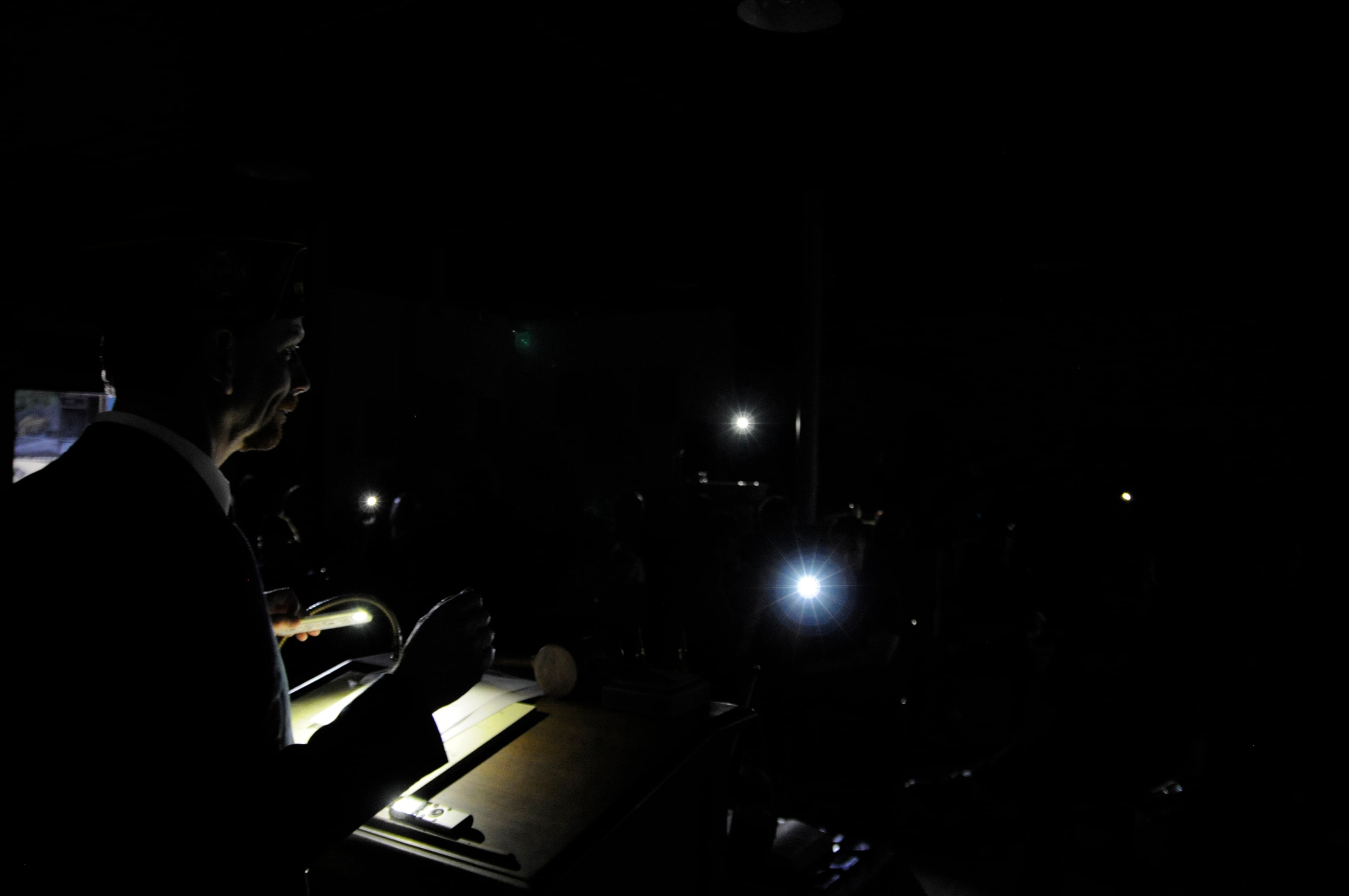
VFW Post 1 members continue with their June monthly meeting during a power outage.
Photo Credit: Jon R. Anderson/Staff
"We're going to keep going, gang," he says, pulling out his cell phone and using its light to read his meeting notes.
Within seconds, the hall comes alive with points of light as the group adds to the glow with their own phones.
Mitchel announces they'll soon be getting a new roof with $90,000 worth of donated labor.
Familiar themes
Ask veterans from the most recent conflicts about the VFW, and some common themes emerge. Many say the VFW all too often is:
- Not focused on the needs of younger vets.
- Dismissive of female veterans.
- Resistant to changing times.
Curtis Bean, who served as an Army scout and sniper through two tours in Iraq, never had the slightest interest in joining the VFW after leaving the military in 2008.
Struggling with post-traumatic stress and seeking a good career fit, Bean says the organization had little to offer.
Local posts he'd seen seemed closed off or worse.
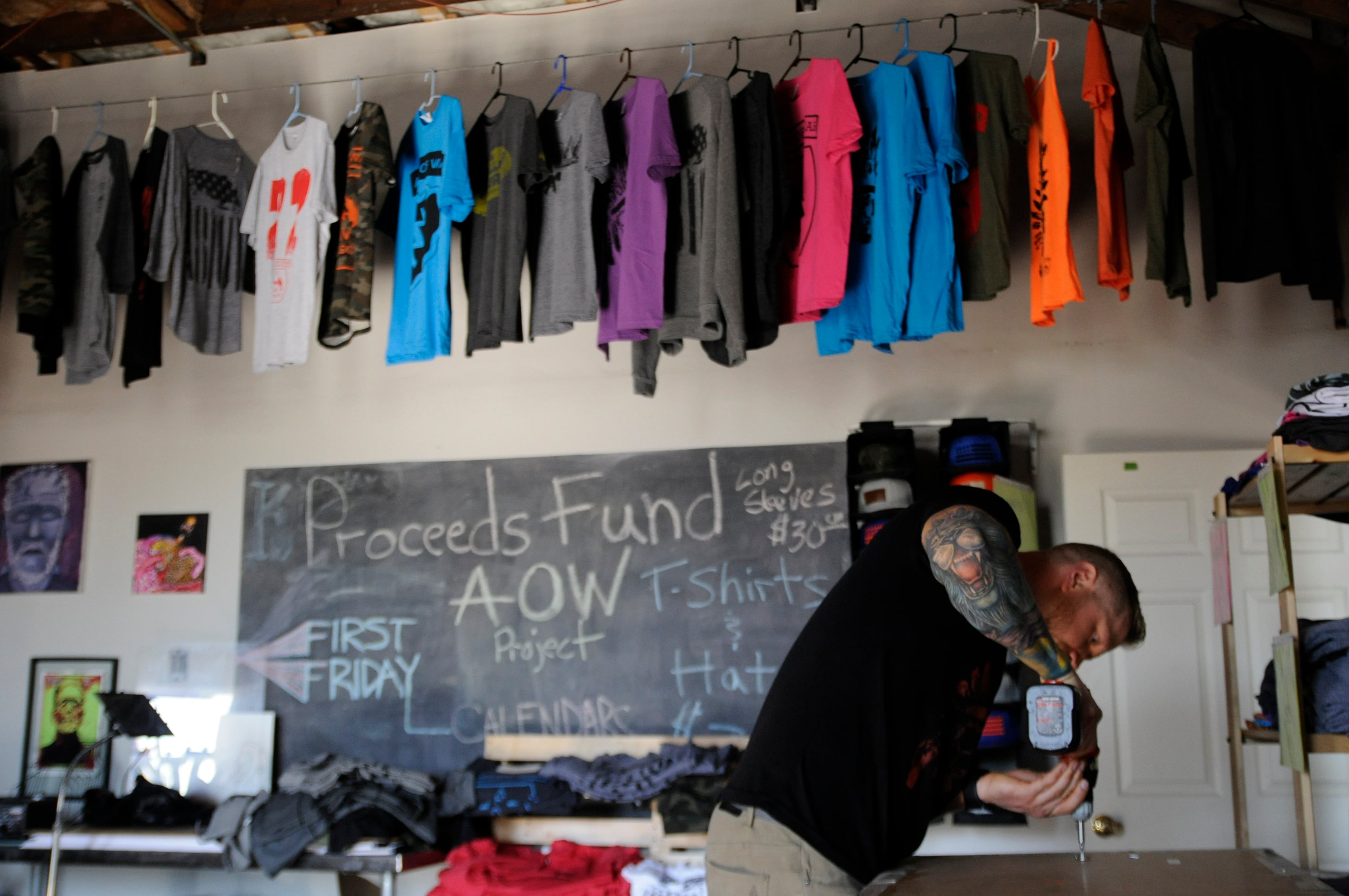
Iraq veteran Curtis Bean, who served in the Army from 2003 to 2008 as a sniper with 10th Mountain Division, started the Art of War Project to help veterans channel their creative energies.
Photo Credit: Jon R. Anderson/Staff
"At most VFWs, you don't feel welcome at all. It's just old guys drinking at their bar, and everyone is looking at you like you don't belong," he says.
"When I came home from Iraq the second time, my family rented out the VFW hall for a welcome home party. It wasn't a positive experience at all. They just made everything hard. Who wants to be part of that?"
For Army intelligence analyst Brittany Bartges, who recently graduated from Metropolitan State University of Denver, joining the VFW was one of the first things she did when returning from her deployment to Iraq with the 1st Infantry Division.
"Even if you don't know much about VFW, you know VFW," she says. "To me, it just seemed like a cool thing to be part of. It was like something I'd earned."
The local post she tried to join, however, did not think much of her.
"They took my application and my money and just threw it away. It was a boys' club, and I had a vagina, so they weren't interested."
John Harry couldn't even imagine a VFW that would welcome him.
A 10-year Air Force veteran who had deployed downrange more than half a dozen times, Harry left the military in 2007. He'd been forced to spend his entire career in the closet because of the ban on open service by gays.
It was not lost on him that top VFW leaders had strongly opposed lifting that ban.
"Repeal advocates are focused primarily on pushing a social agenda about individual rights," said then-VFW National Commander Richard Eubank, a retired Marine and Vietnam veteran, even as the policy was being reversed in 2010. "National security, unit cohesion and morale are the furthest things from their minds."
Eubanks warned: "This social experiment could spell the end of America's all-volunteer military."
So instead of the VFW, Harry joined the Colorado chapter of the American Veterans for Equal Rights.
Despite those early misgivings, however, all three veterans — Bean, Bartges and Harry — now all hold top leadership positions at Post 1.
What changed their minds?
'VFW must change'
Even the military satirists at the Duffel Blog have taken note of the VFW's recruitment and relevancy woes.
"VFW Opens Membership To Military Fakers Due To Lack Of Interest From Young Veterans," trumpeted a fake news story headline in 2013.
Funny or not, the very real problems are not lost on at least some of the VFW's top leaders.
In November, the current national commander put the entire organization "on notice" in a tersely worded memo to all post members.
"I am extremely disturbed by the recurring reports from the field as well as the media's portrayal of the VFW as an organization that is comprised of old and out of touch veterans who would rather drink in a dimly lit canteen than open their doors to our younger veterans," wrote John W. Stroud, a retired Air Force first sergeant.
"The fact remains that the stereotypical, dingy, dark and smoke-filled VFW Post and canteen do exist, but they have no benefit to our organization, provide no aid to our mission nor to the veterans we strive to help and serve."
Stroud, the first non-Vietnam-era veteran to lead the organization since the leadership mantle was passed from the WWII and Korean War generations, chastised older members for not doing more to encourage the latest generation of returning war fighters to join the VFW's ranks.
"To do this, our VFW Posts must change their operational tactics to better reflect the modern crises younger veterans are facing on their new 'battlefield' — the homefront," he wrote.
"For those members and Posts who would rather serve themselves than the countless veterans who are in need, remind them that this organization exists for the benefit of all veterans rather than those of an entitled few."
Petty jealousies and trivial personalities, indeed.
Stroud closed his wake-up call by saying he would rather fire any leader or close any post that refuses to get on board.
"They simply don't belong here," he wrote.
It's no mistake that Post 1's leaders have been invited to the VFW's national convention now getting under way in Pittsburgh. The contingent has been asked to lead two workshops on "Revitalizing Posts & Recruiting Younger Members."
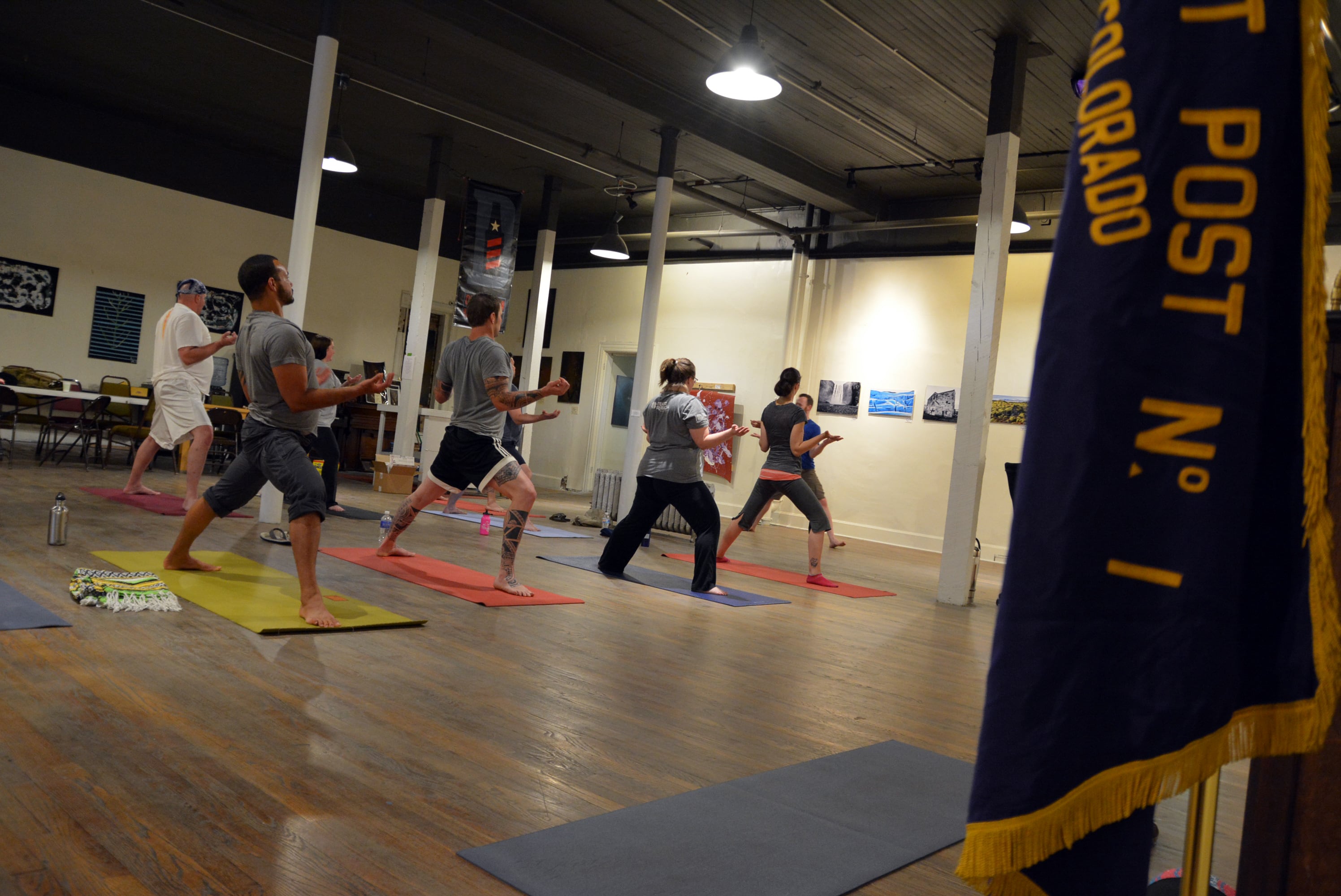
VFW Post 1 members and guests take part in free yoga.
Photo Credit: Jon R. Anderson/Staff
"Post 1 is using progressive means through which they're experiencing great success in recruiting and retaining members," says VFW spokesman Randi Law. "Many other posts are seeking new ideas to help them in their efforts, so here's their opportunity."
Those who take advantage of that opportunity should be prepared to hear how yoga and art classes, among a slew of other new initiatives at Post 1, just might save their post, too.
Keeping things fresh
Pretty soon, the lights are back on and the meeting continues apace.
In another section of the gallery, a group of kids make their own art around a table. A painting of Darth Vader looks on.
Sandwiched between a CrossFit box and another art gallery, in some ways Post 1 is a bit of both. And so much more.
Yoga classes every Tuesday night are run by one of three hardbody Marine Corps veterans. Meditation classes on Wednesdays are led by a cross-legged but straight-talking former Army paratrooper.
On most Thursdays, Bean — the sniper who said he'd never join the VFW — runs his Art of War Project gatherings.
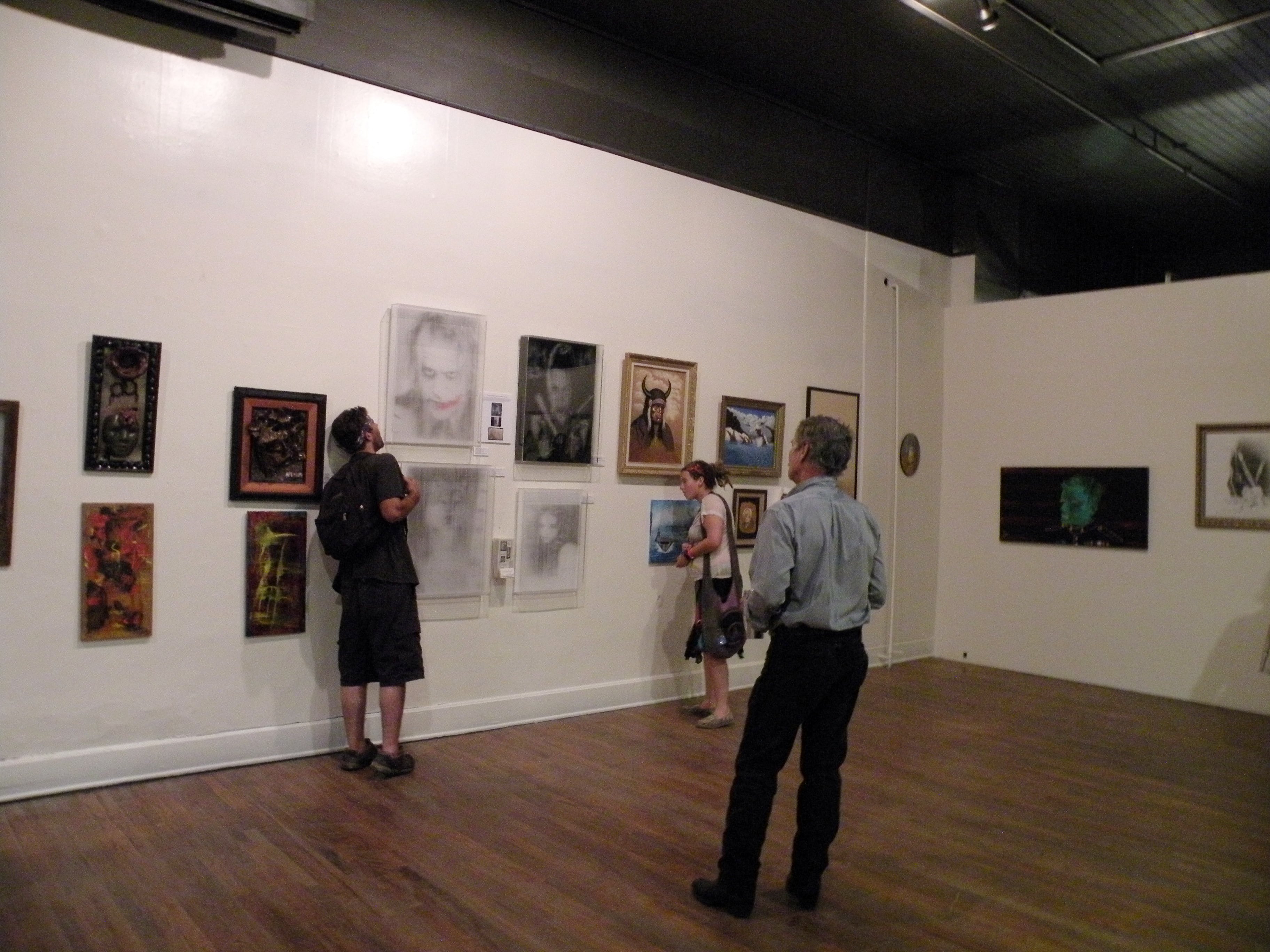
Vietnam veteran Jim Stevens talks about his innovative, holographic-like portraits, painted across hundreds of fishing-line monofilament threads, with visitors to VFW Post 1's First Friday Art Walk exhibition. Stevens recently earned two first-place ribbons at the National Veterans Creative Arts Festival, edging out more than 3,300 other artists.
Photo Credit: Amanda Miller/Staff
On the first Friday of every month, the post opens its doors to thousands who flock to the art district for its monthly art walk. Other Fridays are movie nights, projected on the post's 150-inch pull-down screen.
Then there are all the other community and veterans groups that Post 1 partners with and often provides space for. Back at the post's monthly meeting, for example, a representative from Team Red, White, and Blue is on hand to talk about the fitness-focused veterans program.
"I like to describe what we do here as the being the hub of a wagon wheel," Mitchel says. "There's all these spokes that go out that we can connect you to."
Before the meeting breaks for a networking session, it's time for new Post 1 officers to be installed.
Bartges — the one whose first VFW application was trashed because she was female — is the post's new senior vice commander.
Before the meeting ends, a final prayer is offered by the post's chaplain, World War II Navy veteran Ray Starkey. A post member since 1951, he knew some of the founding members, eventually becoming post commander himself. He's been the chaplain since the 1980s.
He says he loves all the changes: "It keeps things fresh."
He recites the standard prayer from memory as heads bow across the hall.
"... Thou, Who art our strong tower of defense and our protection, grant that in life's battles we may be strong and brave, living such lives of stainless integrity as shall reflect honor upon our country and the Veterans of Foreign Wars of the United States …"
Outside, the storm has passed. The stars are coming out.




